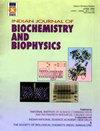Determination of neuroprotective effects of medium chain fatty acids and their derivatives on mutant huntingtin aggregates, oxidative stress and ATP levels in HD150Q cell line model of Huntington’s disease
IF 1.5
4区 生物学
Q4 BIOCHEMISTRY & MOLECULAR BIOLOGY
引用次数: 0
Abstract
Huntington's disease (HD) is a rare autosomal dominant genetic disorder resulting from expansion of polymorphic CAG repeats in the exon 1 of huntingtin gene that translates into elongated polyglutamine (ployQ) tract in huntingtin protein (HTT).PolyQ expansion alters HTT structure resulting in abnormal protein-protein interactions, aggregation, mitochondrial dysfunction, oxidative and endoplasmic reticulum stress, inflammation and altered gene expression leading to neuronal cell death.HD symptoms involves chorea, dementia, behavioural and psychological problems and currently there is no cure highlighting the need for novel therapeutic interventions. Several fatty acids have been reported to have protective effects in neurological disorders including Alzheimer’s disease, Parkinson’s disease and epilepsy. However, their effects in HD is largely unexplored. Neurodegenerative diseases share several common pathways and thus it is likely that a combination of selected fatty acids show neuroprotective effects in HD. This study utilized a cell line model of HD expressing inducible mutant huntingtin fragment with 150 polyQ repeats (HD150Q) to investigate neuroprotective effects of two medium chain fatty acids and one triglyceride. Significant reduction in mutant HTT aggregates and mitochondrial oxidative stress and restoration of ATP levels was observed upon treatment with Decanoic acid, 2-butyloctanoic acid, and Glyceryl triacetate. Encouraging results in the cell line model opens avenues for investigating the underlying molecular mechanisms and validation in the animal models.测定中链脂肪酸及其衍生物对亨廷顿病HD150Q细胞系模型中突变亨廷顿蛋白聚集、氧化应激和ATP水平的神经保护作用
亨廷顿舞蹈病(HD)是一种罕见的常染色体显性遗传病,由亨廷顿蛋白(HTT)外显子1多态性CAG重复扩增引起。PolyQ扩增改变HTT结构,导致蛋白质相互作用异常、聚集、线粒体功能障碍、氧化和内质网应激、炎症和基因表达改变,导致神经元细胞死亡。HD的症状包括舞蹈病、痴呆、行为和心理问题,目前还没有治愈方法,因此需要新的治疗干预措施。据报道,几种脂肪酸对包括阿尔茨海默病、帕金森氏病和癫痫在内的神经系统疾病有保护作用。然而,它们对HD的影响在很大程度上尚未被探索。神经退行性疾病有几个共同的途径,因此很可能是选定脂肪酸的组合在HD中显示出神经保护作用。本研究利用表达150多q重复的诱导突变亨廷顿蛋白片段(HD150Q)的HD细胞系模型,研究了两种中链脂肪酸和一种甘油三酯的神经保护作用。用癸酸、2-丁酸和三醋酸甘油处理后,突变体HTT聚集量和线粒体氧化应激显著降低,ATP水平恢复。细胞系模型中令人鼓舞的结果为研究潜在的分子机制和动物模型的验证开辟了道路。
本文章由计算机程序翻译,如有差异,请以英文原文为准。
求助全文
约1分钟内获得全文
求助全文
来源期刊

Indian journal of biochemistry & biophysics
生物-生化与分子生物学
CiteScore
2.90
自引率
50.00%
发文量
88
审稿时长
3 months
期刊介绍:
Started in 1964, this journal publishes original research articles in the following areas: structure-function relationships of biomolecules; biomolecular recognition, protein-protein and protein-DNA interactions; gene-cloning, genetic engineering, genome analysis, gene targeting, gene expression, vectors, gene therapy; drug targeting, drug design; molecular basis of genetic diseases; conformational studies, computer simulation, novel DNA structures and their biological implications, protein folding; enzymes structure, catalytic mechanisms, regulation; membrane biochemistry, transport, ion channels, signal transduction, cell-cell communication, glycobiology; receptors, antigen-antibody binding, neurochemistry, ageing, apoptosis, cell cycle control; hormones, growth factors; oncogenes, host-virus interactions, viral assembly and structure; intermediary metabolism, molecular basis of disease processes, vitamins, coenzymes, carrier proteins, toxicology; plant and microbial biochemistry; surface forces, micelles and microemulsions, colloids, electrical phenomena, etc. in biological systems. Solicited peer reviewed articles on contemporary Themes and Methods in Biochemistry and Biophysics form an important feature of IJBB.
Review articles on a current topic in the above fields are also considered. They must dwell more on research work done during the last couple of years in the field and authors should integrate their own work with that of others with acumen and authenticity, mere compilation of references by a third party is discouraged. While IJBB strongly promotes innovative novel research works for publication as full length papers, it also considers research data emanating from limited objectives, and extension of ongoing experimental works as ‘Notes’. IJBB follows “Double Blind Review process” where author names, affiliations and other correspondence details are removed to ensure fare evaluation. At the same time, reviewer names are not disclosed to authors.
 求助内容:
求助内容: 应助结果提醒方式:
应助结果提醒方式:


